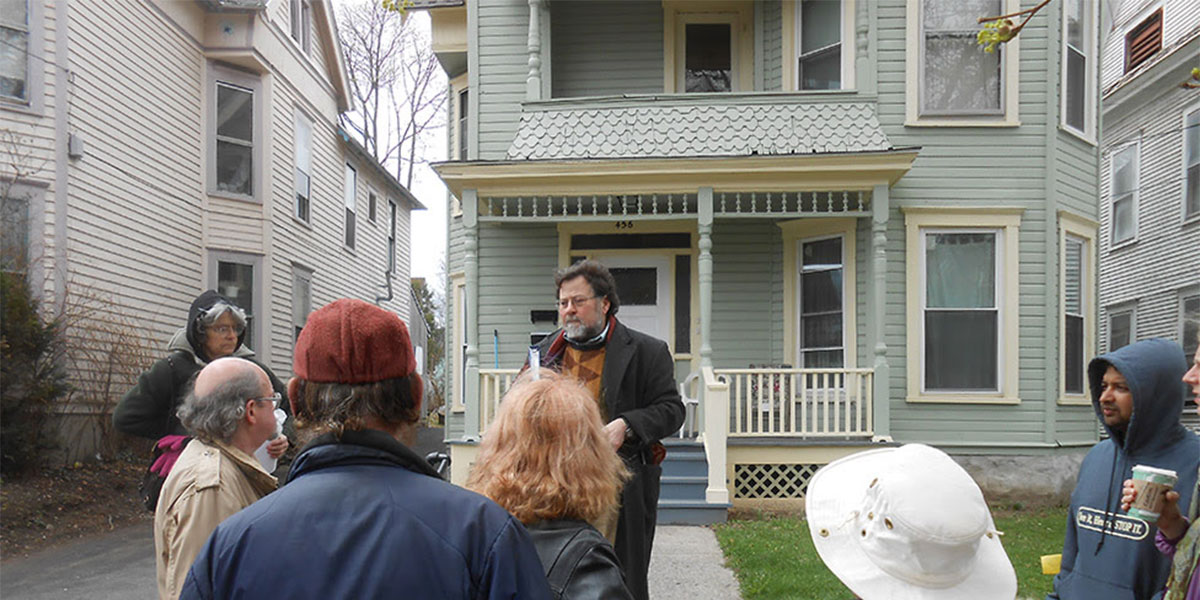History in the Streets and Houses
June 30, 2015
The Westcott Neighborhood, pretty much anyway you define it, is fairly small in area, but big in history. There have not been momentous events here; but thousands of small events combine to tell the history of more than a century and to reveal urban patterns both specific to Westcott and general to similar cities throughout America. One can read much of the neighborhood’s story by looking closely at pavements, buildings, trees, and other signs when walking the sidewalks and driving the streets. In many ways the area is typical of urban neighborhoods of the late 19th and early 20th centuries. It is a “streetcar” suburb, laid over what was probably first an Indian track and then an early settler trail (South Beech Street), and carved out of farmland.
Trolley tracks ran along its major spines–Westcott and Euclid–and rectangular blocks were laid out for easy subdivision and residential development. The technology of the time allowed the first real zoning in Syracuse. Thanks to the wealth of an expanding industrial economy and thrifty behavior encouraged and assisted by new Building Associations, the rising artisan and managerial middle class could afford to buy or build private houses or to rent new flats, far from the congestion, noise, smells and filth of the manufacturing centers of older sections of Syracuse. Private houses were built with easy-to-find patterns using pre-cut lumber and factory-made nails and were filled with modern amenities such as indoor plumbing, ample windows, sleeping porches for ventilation, basement furnaces for heat, electricity for light and, increasingly throughout the early 20th century, new appliances. Sometimes the houses were bought in their entirety – delivered in railroad car-sized building kits. Sometimes local lumbermen and contractors could easily replicate their own popular, but economic, house designs.
In 1890 the Westcott neighborhood was at the edge of the city, one of several new bedroom communities built on every side of the old downtown. Streets were graded and paved, sidewalks were level and ample, shade trees were planted in abundance, and new churches, schools, and even a Fire House, were built to serve the area’s new population. It’s been five generations since the first developers built Queen Anne style houses on Columbus Avenue and Harvard Place, and Colonial Revival and Arts & Crafts Houses on Allen Street and elsewhere, and these houses still stand and serve. Getting to know their distinctive styles and features – whether field-stone foundations or cast stone blocks, narrow wooden clapboards or wide asbestos shingles, corner towers or gambrel roofs – helps dates these houses, and can sometimes suggest the tastes and aspirations of their builders and first occupants.
On a few occasions the neighborhood and its houses have suffered neglect and abuse. Single family houses became crowded boarding houses, lawns were paved over with asphalt, trees either cut down or left untended, and decorative details stripped or covered with cheap aluminum or vinyl siding. Still, the neighborhood has held together. There have been no big demolitions or out-of-scale intrusions. Westcott’s biggest changes took place long ago, as modest–and modestly decorated–commercial structures replaced houses on Westcott Street in the 1920s, and two blocks of that central artery became the Westcott Commercial District. The Westcott Theater–which has gone through several permutations–opened on April 11, 1926 as the Harvard Theater, and has been crucial to the neighborhood’s identity ever since.
Other changes were mostly social in nature. In the 1960s and following, Westcott was the heart of Syracuse’s counter-culture. While there are few vestiges of progressive politics and innovative art forms to be seen in the buildings, some houses–on Avondale and Cambridge for example–remain as cooperative ventures. Today, a new generation of activists and artists call Westcott home.
The Westcott Neighborhood Association has created a series of walking tours, through which one can learn about the history and architecture of individual houses, whole streets, and the neighborhood at large. Walk the neighborhoods and look closely. Look for familiarity, but variety. Every detail has a story–look and listen, and then help us tell them.
